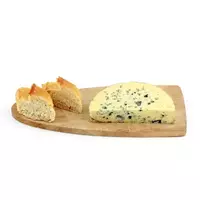Cheese with mold

Researchers claim that cheese with mold appeared in the human diet at the same time as bread and bakery products. In the modern culinary tradition, like many centuries ago, cheese with mold occupies a special place. We think it's no secret that such a food product as cheese with mold is how to speak "amateur. "
Composition of cheese with mold
However, this does not reduce the beneficial properties of cheese with mold, as well as the uniqueness of the benefits for the human body that the product brings. The useful properties of cheese with mold are primarily due to the vitamin-mineral composition, as well as the technology of food production. The chemical composition of mold cheese is enriched with a large amount of protein of natural origin, which is quickly and most importantly fully absorbed by the human body.
It is worth noting that the chemical composition of cheese with mold, as well as the calorie content, depends on the type of product. The average calorie content of mold cheese is 340 Kcal, which is per 100 grams of product. However, the calorie content of cheese with mold can significantly exceed the average. Types of cheese with mold differ, as a rule, in the method of production of the product.
Types of cheese with mold
In addition, the type of cheese with mold depends on the genus of mold mushrooms that are used in the food industry to make the product. For cheese, white mold of the species Penicillium camemberti, as well as Penicillium candidum, is used. This type of mold only covers the outside of the cheese. Among the most famous cheeses with white mold can be called Brie and Camembert.
Red mold is also used to make cheeses. To form red mold, the cheese is exposed to wine, vodka or cider. Cheeses with red mold include Camembert de Normandy, Livaro, Epouasse, and Munster and Rocamadour. And the last species of mold is blue or noble (Penicillium roqueforti, Pencillium glaucum). Perhaps the most popular cheeses with blue mold can be considered Roquefort, Gorgonzola, as well as Dor Blue.
The benefits of cheese with mold
The benefits of cheese with mold are due to the chemical composition of the product, which contains essentially foreign microorganisms. This is the uniqueness of cheese with mold. The real benefit of cheese with mold is the gastrointestinal tract, as well as the digestive system of the human body. In addition, molded cheeses contain large amounts of calcium, phosphorus and vitamins.
Damage to cheese with mold
However, in addition to the benefits, harm from cheese with mold for humans may occur. True, it is worth emphasizing that cheese with mold causes harm only in the case of constant consumption of the product in unlimited quantities. Molded cheeses can significantly worsen the intestinal microflora, as the penicillin found in the product kills both dangerous and beneficial microorganisms.
340 kCal molded cheese
Energy value of cheese with mold (Ratio of proteins, fats, carbohydrates - ju):
Proteins: 20 g (~ 80 kCal)
Fats: 29g (~ 261 kCal)
Carbohydrates: 0 g (~ 0 kCal)
Energy ratio (bj | y): 24% | 77% | 0%
 Español
Español Français
Français Português
Português Русский
Русский 简体中文
简体中文 繁體中文
繁體中文 日本語
日本語 한국어
한국어 العربية
العربية Türkçe
Türkçe Қазақ
Қазақ Deutsch
Deutsch Italiano
Italiano Українська
Українська
